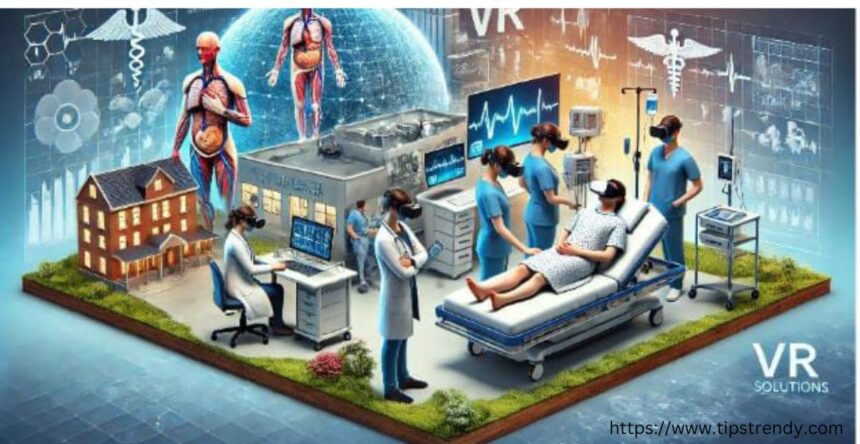The healthcare industry is continuously evolving, embracing advanced technologies to improve patient care and medical training. Among these technologies, Virtual Reality (VR) solutions and 3D animation have emerged as transformative tools. By creating immersive, interactive experiences, these technologies are revolutionizing how medical professionals learn and how patients receive care.
The Rise of VR Solutions in Healthcare
Virtual Reality (VR) solutions have gained significant traction in healthcare for their ability to simulate real-life scenarios without the associated risks. These solutions offer a controlled environment where medical professionals can practice and refine their skills. VR solutions are utilized in various applications, including surgical training, anatomy lessons, and patient therapy.
Enhancing Medical Training with VR
Medical training has traditionally relied on textbooks, lectures, and limited practical experience. VR solutions, however, provide a more dynamic and hands-on approach to learning. Trainees can enter a virtual operating room, practice surgical procedures, and receive instant feedback on their performance. This immersive training helps reduce the learning curve and enhances the competence of future healthcare providers.
Key Benefits of VR in Medical Training:
Risk-Free Environment: Trainees can practice complex procedures without the risk of harming patients.
Repetition and Mastery: VR allows for repeated practice of procedures until proficiency is achieved.
Instant Feedback: Real-time feedback helps learners understand and correct their mistakes promptly.
Access to Rare Scenarios: Trainees can experience and learn from rare medical conditions and emergency situations that they might not encounter during traditional training.
The Role of 3D Animation in Healthcare
A 3D animation company plays a crucial role in creating the detailed, realistic visuals needed for effective VR solutions. These companies use advanced animation techniques to model anatomical structures, simulate physiological processes, and visualize complex medical procedures. The precision and clarity of 3D animations make them invaluable for both educational and clinical purposes.
How 3D Animation Enhances Medical Training
3D animation transforms abstract medical concepts into tangible, visual experiences. For instance, animations can depict the intricacies of cellular processes, the mechanics of surgical techniques, or the progression of diseases. This visual representation aids in the comprehension of complex subjects, making learning more accessible and engaging.
Applications of 3D Animation in Medical Training:
Anatomy Lessons: Detailed animations of the human body help students learn anatomy more effectively.
Procedure Demonstrations: Animations illustrate the steps of surgical procedures, enhancing understanding.
Pathophysiology: Visualizing how diseases affect the body provides deeper insights into their mechanisms.
Patient Education: 3D animations can also be used to explain medical conditions and treatments to patients, improving their understanding and compliance.
Improving Patient Care with VR and 3D Animation
Beyond training, VR solutions and 3D animation are also enhancing patient care. These technologies offer innovative ways to diagnose, treat, and manage health conditions.
VR Solutions in Patient Care
Pain Management: VR experiences can distract patients from pain during medical procedures or chronic pain management.
Rehabilitation: VR-based exercises and games make physical therapy more engaging and effective.
Mental Health Therapy: VR environments are used to treat anxiety, PTSD, and other mental health conditions through exposure therapy and relaxation techniques.
3D Animation in Patient Care
Surgical Planning: Surgeons use 3D animations to plan and rehearse complex surgeries, improving outcomes.
Patient Communication: 3D animations help doctors explain diagnoses and treatment plans to patients clearly.
Custom Prosthetics: Animation and modeling technologies assist in designing custom prosthetics and implants tailored to patients’ unique anatomy.
The Future of VR and 3D Animation in Healthcare
As technology continues to advance, the integration of VR solutions and 3D animation in healthcare is expected to expand further. Future developments may include:
Enhanced Realism: Improved graphics and haptic feedback will make VR experiences even more lifelike.
AI Integration: Artificial intelligence will enhance the capabilities of VR and 3D animation, providing more personalized and adaptive learning experiences.
Remote Training and Care: VR solutions will facilitate remote medical training and patient care, breaking down geographical barriers.
Conclusion:
In conclusion, the collaboration between VR solutions and 3D animation companies is revolutionizing healthcare. These technologies are not only transforming medical training by providing immersive, interactive learning experiences but also enhancing patient care through innovative applications. As the healthcare industry continues to embrace these advancements, the future promises even more exciting developments, ultimately leading to better healthcare
